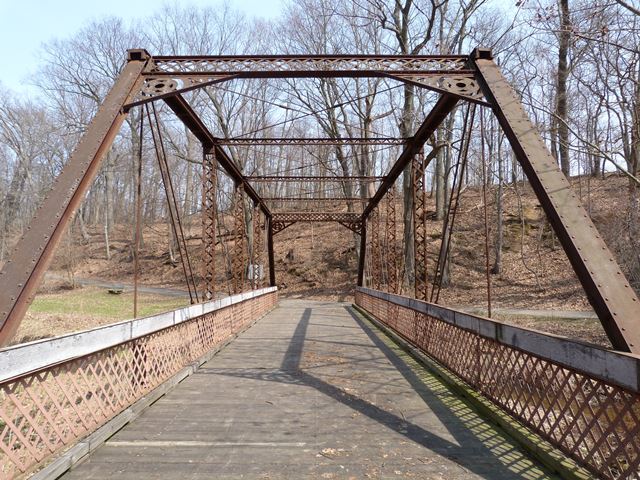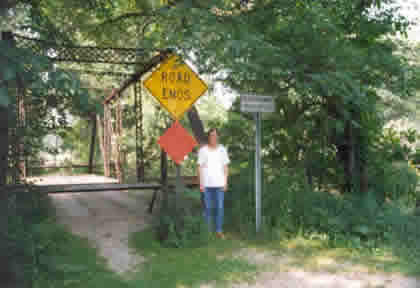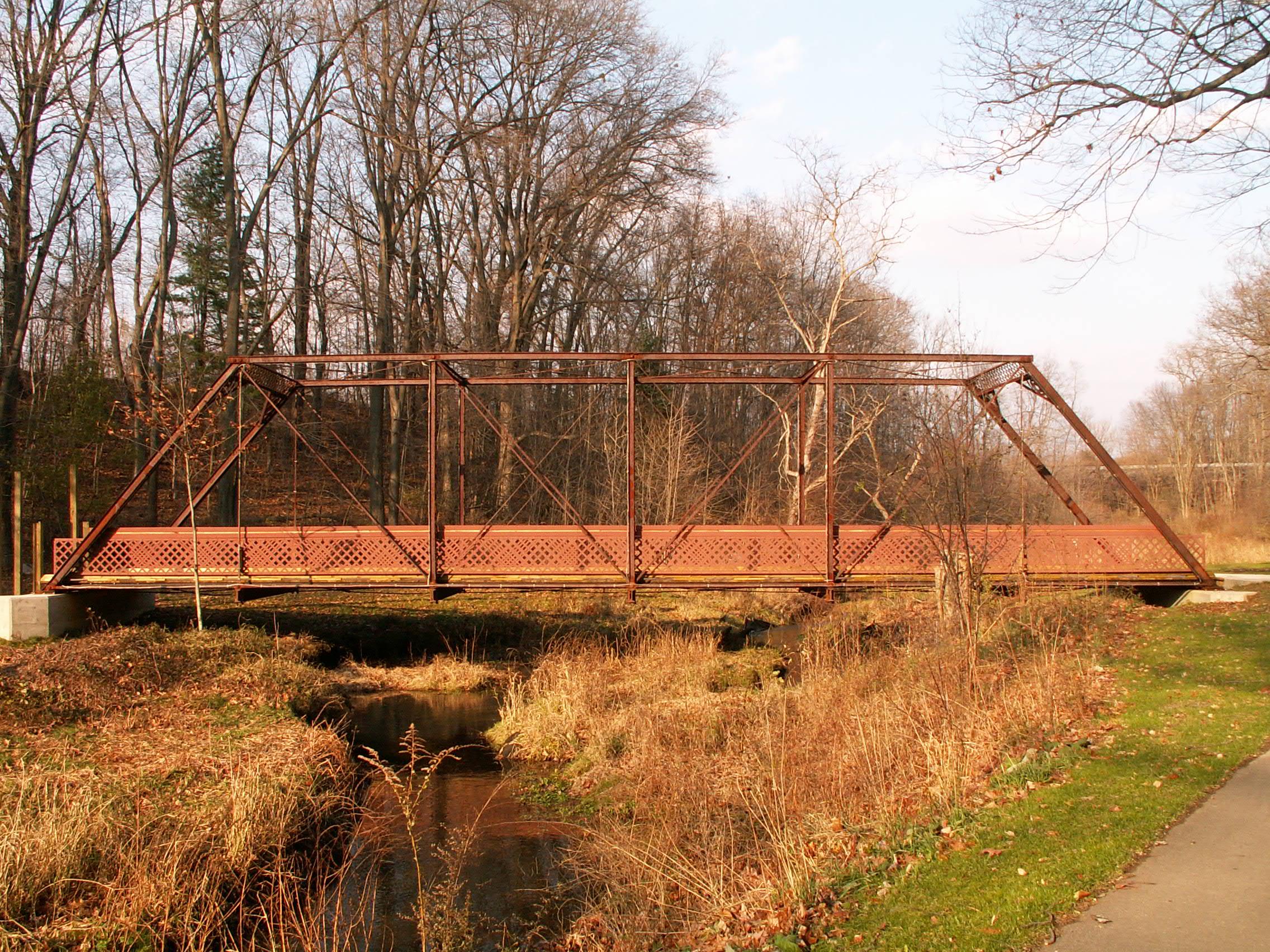We Recommend:
Bach Steel - Experts at historic truss bridge restoration.
BridgeHunter.com Phase 1 is released to the public! - Visit Now
Bauer Road Bridge

Primary Photographer(s): Nathan Holth
Bridge Documented: November 20, 2005 - April 16, 2014
Rural: Calhoun County, Michigan: United States
1880 By Builder/Contractor: Penn Bridge Company of Beaver Falls, Pennsylvania
Not Available or Not Applicable
89.0 Feet (27.1 Meters)
89.0 Feet (27.1 Meters)
16 Feet (4.88 Meters)
1 Main Span(s)
19315H00011B010

View Information About HSR Ratings
Bridge Documentation
View Archived National Bridge Inventory Report - Has Additional Details and Evaluation
View Historic American Engineering Record (HAER) Documentation For This Bridge
HAER Data Pages, PDF
This bridge has been moved and restored, and now resides in Historic Bridge Park.
This bridge has not been painted because it is wrought iron. Wrought iron does not rust like steel does, and thus painting the bridge was not going to offer any noticeable benefit. This bridge is one of the oldest truss bridges in Michigan, with its 1880 construction date. It was built by a significant company, the Penn Bridge Works of Beaver, Pennsylvania. The railing on the bridge is a larger lattice than on the other bridges because of some issues that developed with safety. As an old truss bridge, the bridge is overall a light duty bridge. All members and chords are smaller than what the average pin-connected Pratt through truss from later years consisted of. The height of the truss is quite short also, although the deck width is average, which results in this bridge having a false wide feeling to it. Compare this to the Gale Road Bridge which has the same approximate width but is taller. The bottom chord is highly unusual on this bridge. The eye-bars that form the bottom chord in the middle four panels on the bridge have eye-bars with three eyes. In other words, that one eye-bar spans two panels. Another unusual feature is the end-post/top chord connection (the hip joint) which actually has two pins, one for the vertical and one for the diagonal. This is a design characteristic that appears on most older truss bridges built by the Penn Bridge Company. The way the top chord terminates at the end post is less commonly seen also. In the case of this bridge, there would have been a plaque mounted on the end of the top chord to hide the "guts" of the top chord. This design technique shows up again on older Penn Bridge Company structures, but the Wrought iron Bridge Company was also noted for doing this as well. The Portal bracing is ornate, and in addition to the lattice also features a decorative flower-shaped punch-out on the corners. If you look closely, you can see the serrated edge on this design which shows that the design was punched out of the metal. Another detail to note when you examine the portal up close is that there are little buttons on the middle of the lattice portion of the portal bracing. Sadly, all but a couple are left today. If you look very close, you can make out "PENN" written on them. Again, this was an interesting thing that shows up on older Penn Bridge Company bridges.
During the restoration of this bridge, crews utilized some parts from a Tallman Road Bridge, which was located near to the Bauer Road Bridge in Clinton County. The HAER documentation links above offer details and a photo-documentation of that bridge.
Information and Findings From Michigan Historic Bridge InventoryNarrative Description
The Bauer Road Bridge is one of only two known surviving examples of
through truss spans built in Michigan by the Penn Bridge Works of Beaver
Falls, Pennsylvania, an important eastern bridge company in the
nineteenth century. |
This bridge is tagged with the following special condition(s): Reused
![]()
Photo Galleries and Videos: Bauer Road Bridge
2005 Bridge Photo-Documentation
A collection of overview and detail photos. This photo gallery contains a combination of Original Size photos and Mobile Optimized photos in a touch-friendly popup viewer.Alternatively, Browse Without Using Viewer
![]()
2014 Bridge Photo-Documentation
Original / Full Size PhotosA collection of overview and detail photos. This gallery offers photos in the highest available resolution and file size in a touch-friendly popup viewer.
Alternatively, Browse Without Using Viewer
![]()
2014 Bridge Photo-Documentation
Mobile Optimized PhotosA collection of overview and detail photos. This gallery features data-friendly, fast-loading photos in a touch-friendly popup viewer.
Alternatively, Browse Without Using Viewer
![]()
Maps and Links: Bauer Road Bridge
The above map shows the current location of the bridge. The bridge originally crossed the Looking Glass River on Bauer Road, Clinton County, Michigan.
Coordinates (Latitude, Longitude):
Search For Additional Bridge Listings:
Bridgehunter.com: View listed bridges within 0.5 miles (0.8 kilometers) of this bridge.
Bridgehunter.com: View listed bridges within 10 miles (16 kilometers) of this bridge.
Additional Maps:
Google Streetview (If Available)
GeoHack (Additional Links and Coordinates)
Apple Maps (Via DuckDuckGo Search)
Apple Maps (Apple devices only)
Android: Open Location In Your Map or GPS App
Flickr Gallery (Find Nearby Photos)
Wikimedia Commons (Find Nearby Photos)
Directions Via Sygic For Android
Directions Via Sygic For iOS and Android Dolphin Browser
USGS National Map (United States Only)
Historical USGS Topo Maps (United States Only)
Historic Aerials (United States Only)
CalTopo Maps (United States Only)



